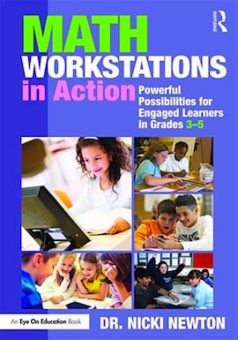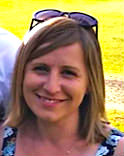Using Math Workstations for Engaged Learning
Math Workstations in Action: Powerful Possibilities for Engaged Learning in Grades 3-5
By Dr. Nicki Newton
(Routledge/Eye On Education, 2018 – Learn more)
In my search for a resource to help me better integrate math stations into my classroom as I moved to a new grade level, I found Math Workstations in Action. Seeing that this book was written by Dr. Nicki Newton, well known and respected for her work with math running records, I eagerly dove in to see what insights she could provide.
Newton divides the book’s twelve chapters into four logical parts: an overview, chapters devoted to each of the four must-have stations, additional unit-specific workstations, and assessment.

She lays out how to make workstations function in your classroom, including a suggested rollout and management system, before delving into the specifics of each type of station. It was just what I needed to help me wrap my head around a vision of how they would look and feel in my classroom.
As Parts II-IV progress, each chapter is set up similarly for ease of use with:
♦ Big ideas and enduring understandings,
♦ What it means (what the workstation should look like in this unit),
♦ Anchor charts that should accompany each type of station,
♦ Activities broken down by type with figures showing clear examples of stations and the “I can” statements to go with them,
♦ Graphic organizers you can use to help keep students accountable and to help you in assessing their progress, and
♦ A chart listing picture books, videos, virtual tools, and internet games/resources – offering more ideas for how to teach the math fluencies as well as integrate them into workstations.
One of the most helpful things about this book is how every chapter has reflection questions for the teacher, making it easier to take what you’ve just learned and apply it. These were especially beneficial to me in thinking through how I could use what Newton teaches in my own practice.
Fixed and flexible stations
Math Workstations in Action makes the case for workstations that stay all year, like for targeted fluencies, word problems, vocabulary and writing, a digital workstation if that isn’t included in other stations, and possibly one for place value since many students have gaps in this area of understanding.
Added to these fixed stations, but not fixed activities, should be rotating stations from your current unit of study. Newton gives clear examples of the kinds of activities, providing copious figures to demonstrate what each type of workstation could be and how it can be differentiated depending on the level of learner.
Her ideas for culminating activities and choice boards using posters, games, and glogs are reminiscent of things I’ve done in the past for language arts, and I loved seeing the application of these in math.
Linking assessment into stations
The final section was my favorite, linking in assessment – a passion of mine. Newton provides a range of assessment ideas beginning with pre-assessments to guide what stations students need to visit and what level they will be working at and moving on to. She gives examples of how students can keep track of activity sheets (NOT worksheets), how to easily record/keep anecdotal records, checklists for teachers and for students to monitor their own progress – all great for our move toward mastery-based learning, and portfolio ideas.
I’ll be honest in saying that, while I have used math stations in the past, they certainly weren’t the workstations described in this book. My one-size-fits-all rotations weren’t meeting the needs of all my students, I was having trouble keeping them accountable for the work done in stations, and it was often just a way to occupy them until it was time for guided math groups.
I now have a clear picture and a set of steps to organize workstations based on needed fluencies and focus standards. I also know how to gauge the progress my students are making and where to take them next. I already have copious notes after working through “Appendix A: An Action Plan for Making it Happen.”
I’ll be sharing this book!
I usually have some criticism of the professional books I read, something I wish the author had done but didn’t. This book was so clear and had so many examples that, short of including all the workstations to print out, there isn’t much room for improvement. Math Workstations in Action is a book begging to be shared with the other teachers in my grade-level and throughout my building.
Rebecca Crockett is a secondary English turned elementary teacher in her twelfth year of teaching. She currently teaches fifth grade math and reading. Since 2013 she has been part of the Idaho Coaching Network whose focus is providing professional development and improving teacher practice around the CCSS. Rebecca lives in north central Idaho with her husband and two children.





































